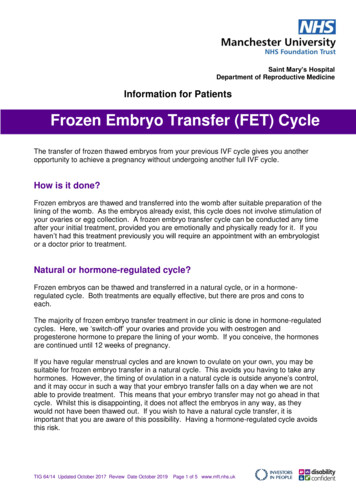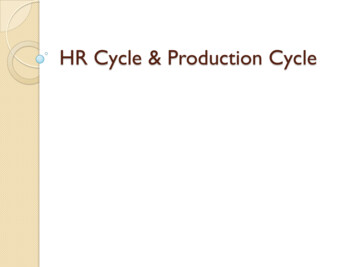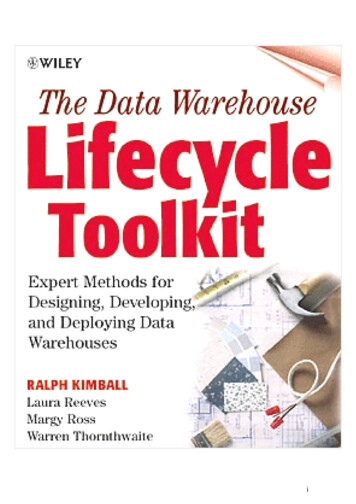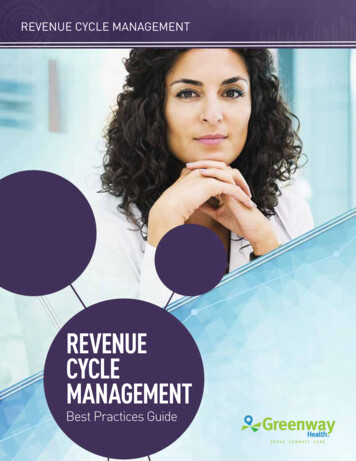
Transcription
Saint Mary’s HospitalDepartment of Reproductive MedicineInformation for PatientsFrozen Embryo Transfer (FET) CycleThe transfer of frozen thawed embryos from your previous IVF cycle gives you anotheropportunity to achieve a pregnancy without undergoing another full IVF cycle.How is it done?Frozen embryos are thawed and transferred into the womb after suitable preparation of thelining of the womb. As the embryos already exist, this cycle does not involve stimulation ofyour ovaries or egg collection. A frozen embryo transfer cycle can be conducted any timeafter your initial treatment, provided you are emotionally and physically ready for it. If youhaven’t had this treatment previously you will require an appointment with an embryologistor a doctor prior to treatment.Natural or hormone-regulated cycle?Frozen embryos can be thawed and transferred in a natural cycle, or in a hormoneregulated cycle. Both treatments are equally effective, but there are pros and cons toeach.The majority of frozen embryo transfer treatment in our clinic is done in hormone-regulatedcycles. Here, we ‘switch-off’ your ovaries and provide you with oestrogen andprogesterone hormone to prepare the lining of your womb. If you conceive, the hormonesare continued until 12 weeks of pregnancy.If you have regular menstrual cycles and are known to ovulate on your own, you may besuitable for frozen embryo transfer in a natural cycle. This avoids you having to take anyhormones. However, the timing of ovulation in a natural cycle is outside anyone’s control,and it may occur in such a way that your embryo transfer falls on a day when we are notable to provide treatment. This means that your embryo transfer may not go ahead in thatcycle. Whilst this is disappointing, it does not affect the embryos in any way, as theywould not have been thawed out. If you wish to have a natural cycle transfer, it isimportant that you are aware of this possibility. Having a hormone-regulated cycle avoidsthis risk.TIG 64/14 Updated October 2017 Review Date October 2019Page 1 of 5 www.mft.nhs.uk
What do you need to do?Ring (0161) 276 6000, press option 1, between 8.00 am –11.00 am on the first day of yourperiod to request treatment. Having checked through your medical notes and ensuring allrelevant information is up to date, the nurses will call you within 72 hours of your treatmentrequest to let you know if we can offer treatment that month. Please note it is not alwayspossible to accept all requests and you may be told to ring again the following month.Please ensure that you do not have unprotected intercourse from the first day of yourperiod until after the embryo transfer.Treatment cycle proceduresOnce it has been confirmed you can have treatment that month, you need to avoidunprotected intercourse. You will be asked to attend the unit between approximately Day18-23 of your cycle so that the nurse can explain the thaw policy and the treatment you willundertake. The nurses will also teach you how to self-administer injections with a very fineneedle-injection just under the skin to suppress your natural hormones. This is maintaineduntil you are ready to receive your oestrogen tablets. All drugs are delivered to your homeaddress prior to the commencement of treatment. You, and where applicable yourpartner, will be required to sign a patient agreement prior to any embryos being thawed.We may use either Buserelin daily injections or alternatively Prostap injections which is aonce only injection and works for 4 weeks. Common side effects of the medicines usedinclude: nausea, headaches, tiredness, stomach cramps, mild diarrhoea, breakthroughbleeding, breast tenderness, mood swings, hot sweats and vaginal dryness. These aredue to a fall in your oestrogen levels and will disappear once you start taking Oestrogen.There are other less common side effects listed on the information leaflet in the box oftablets. Please contact either the unit or your GP if you experience any of these.Approximately two weeks later, you will be given an appointment to attend for a blood test.This blood test is to check your hormone levels. If you have not had a period during thistime, please inform the unit on the day before your blood test appointment on (0161) 2766000 (press option 2) as we will have to rearrange your appointment.If your hormone levels are satisfactory, the nurses will give you specific instructions onwhen to start your Oestrogen tablets/patches to build up the endometrium (the lining of thewomb). You will then come back to the unit 15 days later for a trans-vaginal scan to checkif the tablets have thickened the lining sufficiently. There is some variation in how well thelining of the womb develops with some people being more responsive than others. If thelining is not thick enough a doctor will review your notes and make a plan accordingly. Ifthe thickness of the womb lining is adequate, we will ask you to start progesteronepessaries while continuing on the oestrogen tablets, and give you a date for embryotransfer.This start date will vary depending on the availability of embryo transfer days.Progesterone is provided in the form of pessaries, which help to support the lining of thewomb. You will be given specific instructions on how to use these by the nurses. Thepessaries can be inserted into the vagina or the back passage. Pessaries should be usedTIG 64/14 Updated October 2017 Review Date October 2019Page 2 of 5 www.mft.nhs.uk
12 hours apart – one in the morning and one in the evening. On the morning of the day ofyour embryo transfer, please insert the pessary in your back passage rather than thevagina. Side effects of Cyclogest pessaries include vaginal irritation, headaches, chestpains, weakness, fatigue and dizziness. If you experience side effects, please contact theunit for advice.Before embryo transferOn the morning of embryo transfer an embryologist will telephone you to let you knowwhether the embryos survived the thaw process and to give you a time to attend the unitfor the replacement. This could be on the same day or after 1-3 days of embryo culture.You will be asked to attend with a full bladder, as an abdominal scan will be carried out tohelp the doctor with positioning the transfer catheter. The replacement procedure isrelatively painless (similar to a smear test) and takes around 15 minutes. No anaestheticis necessary and your partner can come into theatre with you. The embryologist willadvise you on the number of embryos to be transferred. We aim to provide a good chanceof success whilst keeping the risk of multiple pregnancy low, as this is associated with ahigher risk of complications for both the mother and babies.Following your replacement You will be able to go straight home after your replacement if you feel well. If required,you may use paracetamol to relieve any mild pain or discomfort. You may experience mild pain, slight vaginal discharge/water loss from the cervixand/or vaginal bleeding. These are common symptoms and do not indicate if yourtreatment has or has not been successful. Please continue your tablets and pessariesuntil your contact date. A delayed period does not necessarily indicate a pregnancy asthe progesterone may stop you from having a bleed. Please carry out your pregnancytest on the date you have been given. You should use the first urine sample in themorning and a good quality pregnancy test kit available from a Chemist.OutcomeIf your pregnancy test is negative on your contact date you may stop the tablets andpessaries. If you wish to start a new frozen embryo cycle, you will need to wait until yournext period starts. If you do not have any embryos left in storage, your notes will bepassed onto our unit meeting. This is where your treatment will be reviewed by aconsultant, embryologist, nurse and counsellor, and a plan made for your next steps. Youwill receive a letter within three to four weeks of the contact date advising you of the plan.If your test is positive, you will be asked to come in for a scan three weeks later to checkthe position of the pregnancy as well as the number and heartbeat(s) of the implantedembryo(s). The tablets and pessaries should then be continued until week 12 of thepregnancy. Once the pregnancy is confirmed by scan, the nurse will give you furtherTIG 64/14 Updated October 2017 Review Date October 2019Page 3 of 5 www.mft.nhs.uk
instructions regarding this medication. Folic acid and Vitamin D should also be continueduntil 12 weeks of pregnancy.Important points relating to stored embryos HFEA regulations permit the embryo storage for a maximum of ten years, for longeronly in exceptional cases. It is important for you to keep in touch with us about your wishes for stored embryos.You may choose to maintain them in storage, discard them, have them replaced toyourself or donate them to other couples after submitting written consent andagreement of both partners. You will also be asked to state your wishes for your stored embryos in the event ofdeath or mental incapacitation. This will be discussed with you in clinic, but it isextremely important that you inform us of any changes in your situation or wishes. Ifwe are unable to contact you and the storage period for your stored embryos hascome to an end, we will have no option but to allow your embryos to perish. Survival of frozen embryos; approximately 80% of frozen embryos survive the processof thawing.Contact numbers To request treatment: Ring (0161) 276 6000, press option1 only (8.00 am – 11.00 am,7 days a week). To make an appointment with doctors/counsellors: Ring (0161) 276 6000, pressoption7 (8.30 am – 4.00 pm, Monday – Friday). All other enquires to the nurses should be made via (0161) 276 6000 press option 2,(7.30 am – 4.15 pm, Monday – Friday or 8.00 am – 3.45 pm, Saturday and Sunday).For out of hours EMERGENCY ONLY:Ward 62 – (0161) 276 6105/6410 orEGU (Emergency Gynaecology Unit) on (0161) 276 6204 (8.00 am – 9.30 pm)TIG 64/14 Updated October 2017 Review Date October 2019Page 4 of 5 www.mft.nhs.uk
TIG 64/14 Updated October 2017 Review Date October 2019Page 5 of 5 www.mft.nhs.uk
opportunity to achieve a pregnancy without undergoing another full IVF cycle. How is it done? Frozen embryos are thawed and transferred into the womb after suitable preparation of the lining of the womb. As the embryos already exist, this cycle does not involve stimulation of your ovaries or egg collection. A frozen embryo transfer cycle can be conducted any time after your initial treatment .











